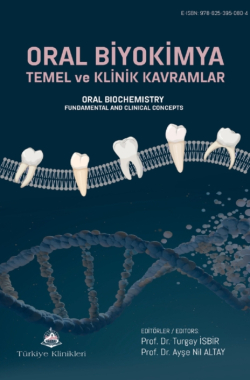Genetik Mekanizmalar ve Epigenetik
F. Tuba Akdeniz
Genetik, biyolojik organizmaların varoluşunu, fonksiyonunu ve çeşitliliğini tanımlayan bilim dalıdır. Genler, DNA’da yer alan stabil yapılar olup, hücresel işlevleri, fizyolojik gelişimi ve bireysel özellikleri kodlar. Epigenetik ise genlerin ifade edilmesini veya susturulmasını etkileyen, DNA dizisini değiştirmeyen dışsal ve içsel faktörleri inceleyen bir alandır. Bu bölüm, genetik ve epigenetik ilke ve mekanizmalarının, özellikle mutasyon, DNA tamiri ve kanserle olan ilişkisini detaylı bir şekilde ele almaktadır. Ayrıca genetik hastalıkların epigenetik mekanizmaları ile, bu durumun diş hekimliğinde ağız dokularında oluşturduğu değişiklikler açıklanmıştır.
×
Kaynak Göster
Referanslar
- Buggenhout G V & Forestier I B. (2008). Mesiodens. European journal of medical genetics, 51(2), 178-181. [Crossref]
- Buonavoglia A, Lanave G, Camero M, Corrento M, Parisi A, Martella V, Prati C (2021) Next -Generation Sequencing Analysis of Root Canal Microbiata Associated with a Severe Endodontic- Periodontal Lesion. Diagnostics. [Crossref]
- CSIRO Division of Biomolecular Engineering, Sydney Laboratory, North Ryde, Australia. Model of epigenetic disorder. Genes, 12(7), 968.
- De Laval B, Pawlikowska P, Barbieri D, Besnard-Guerin C, Cico A, Kumar R, & Porteu F (2014) Thrombopoietin promotes NHEJ DNA repair in hematopoietic stem cells through specifc activation of Erk and NF-κB pathways and their target, IEX-1. Blood, The Journal of the American Society of Hematology. 123(4), 509-519. [Crossref]
- Di Risi T, Vinciguerra R, Cuomo M, Della Monica R, Riccio E, Cocozza, S, & Chiariotti L. (2021). DNA methylation impact on Fabry disease. Clinical Epigenetics. 13, 1-9 [Crossref]
- Herrmann S. M, Adler Y D, Schmidt-Petersen K, Nicaud V, Morrison C, Paul, M., & Zouboulis, C. C. (2003). The concomitant occurrence of multiple epidermal cysts, osteomas and thyroid gland nodules is not diagnostic for Gardner syndrome in the absence of intestinal polyposis: a clinical and genetic report. British Journal of Dermatology, 149(4), 877-883. [Crossref]
- Hsieh PL, Huang CC, Yu CC (2021) Emerging Role of microRNA200 Family in Dentistry. Non-coding RNA. [Crossref]
- Huang P, Wang F, Wang X, Meng X, Qiao W, & Meng L (2023). RNA-sequencing analysis reveals the potential molecular mechanism of RAD54B in the proliferation of infamed human dental pulp cells. International Endodontic Journal. 56(1), 39-52. [Crossref]
- Hussian A, Tebyaniyan H, Khayatan D (2022) The Role of Epigenetic in Dental and Oral Regenerative Medicineby Different Types of Dental Stem Cells: A Comprehensive Overview Stem Cells Int doi: 10.1155/2022/5304860 [Crossref]
- Irimie A I, Ciocan C, Gulei D, Mehterov N, Atanasov A G, Dudea D, & Berindan-NeagoeI. (2018) Current insights into oral cancer epigenetics. International journal of molecular sciences. 19(3), 670. [Crossref]
- Kurisu K, Tabata MJ (1997) Human Genes for Dental Anomalies. Oral Dis.3(4), 223-8 [Crossref]
- Laine M, Loos BG, Crieleaard W (2010) Gene Polymorphism in Chronic Periodontitis.International Journal of Dendistryt. [Crossref]
- Liao H M, Niu D M, Chen Y J, Fang J S, Chen S J, & Chen C H (2011) Identifcation of a microdeletion at Xp22. 13 in a Taiwanese family presenting with Nance-Horan syndrome. Journal of human genetics. 56(1), 8-11 [Crossref]
- Lin YX, HA PK (2016) Genetic Alteration Salivary Gland. Cancer. 122(12), 1822-1824. [Crossref]
- Martinez PM, Pastor PJA, Illueca FA, Roldan AL (2021) MicroRNAs and periodontal disease: a qualitative systematic review of human studies. J. Periodontal Implant Scı. 51(6), 386-397. [Crossref]
- Ochojska JJ, Rygiel K, Stefannska LP (2019) Disease of Oral Cavity in light of the newest epigenetic research: Possible implication for stomatology. Adv Clin Exp Med. 28(3), 397-406. Rupp W.D. (2013) Early Days DNA Repair: Discovery of Nucleotide Excision Repair and Homology Dependet Recombinational Repair. Yale J Biol Med. 86(4), 499-505 [Crossref]
- Seo J Y, Park Y J, Yi YA, Hwang J Y, Lee I B, Cho B H, Son H H, Seo G D (2015) Epigenetics: general characteristics and implications for oral health. Restor Dent. Endod. 40(1), 14-22 Shulz S, Schaller HG, Immel U, Just L, Glaser C, Reicherd S (2016) Epigenetic Characteristic in Infamatory candidate genes in aggressive periodontitis: The role of Interleukin 17C and CCL25. Hum Immunol. 77(1), 77-75. [Crossref]
- Subasioglu A, Savas S, Kucukyilmaz E, Kesim S, Yagci A, Dundar M (2015) Genetic background of supernumerary teeth. Eur J Dent. 9(1), 153-158. [Crossref]
- Sweeat JD, Nestler EJ, Meaney MJ, Akbarian S (2013) An Owerview of the Molecular Bases of Epigenetics. Epigenetic Regulation in the Nervous System. [Crossref]
- Tarannum F, Faizuddin M (2012) Effect of gene polymorphisims on periodontal diseases. Indian Journal of Human Genetics. [Crossref]
- Van Gils J, MagdinierF, FergelotP., & LacombeD. (2021). Rubinstein-Taybi syndrome: a model of epigenetic disorder. Genes, 12(7), 968. [Crossref]
- Wang Y, Zhang J, Wu L, Liu W, Wei G, Gong X, & CheL. (2018) Tricho-rhino-phalangeal syndrome 1 protein functions as a scaffold required for ubiquitin-specifc protease 4-directed histone deacetylase 2 de-ubiquitination and tumor growth. Breast Cancer Research, 20(1), 1-14. [Crossref]
- Wang Y, Zhang Y (2014) Regulation of TET protein Stability by Calpains. Cell Rep. 6(2), 278-284. [Crossref]
- Yamaguchi T, Kawaguchi A, Kim Y, Haga S, Katayama K, Ishida H, Park SB, Maki K, Kimura R (2014) The role of polymorphism associated with early tooth eruption in dental and occlusal traits in East Asian Population. Korean J Orthod. 44(2), 96-102. [Crossref]
- Zhai Y, Wei R, Liu, J., Wang H., Cai W, Zhao M, & Liu S (2017). Drug-induced premature senescence model in human dental follicle stem cells. Oncotarget. 8(5), 7276. [Crossref]
- Zhang D, Zhang C, Zhu Y, Xie H, Yue., Li M, & GuanY (2023). Recruitment of transcription factor ETS1 to activated accessible regions promotes the transcriptional program of cilia genes. Nucleic Acids Research. 51(13), 6684-6701. [Crossref]

